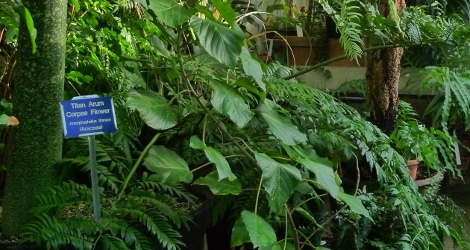Accession Data:
Xanthorhiza simplicissima Marshall
- Common Name: Yellowroot
- Family: Ranunculaceae Juss.
- Description: Named for the color of its inner bark and roots; native to the Atlantic coastal regions of New Jersey, Virginia and inland to Kentucky; a tall groundcover (3') good for banks or slopes, it spreads by underground rhizomes; tolerant of dry as well as heavy soils; flowers early before leaves appear, a not particularly showy racemose panicle or drooping cluster of brownish purple flowers; lustrous green foliage turning yellow, bronze or red in fall.
- Uses: It contains the alkaloid berberine, which has a number of traditional and contemporary uses for dyeing and medicine.4
- IMPORTANT NOTE: Plant Uses are for informational purposes only. EEB Greenhouses assume no responsibility for adverse effects from the use of any plants referred to on this site. Always seek advice from a professional before using any plant medicinally.
- USDA Zone: 6a-8b
Accession Data:
- Accession # 199800019
- Source: ArborVillage
- Accession Date: 03-28-1998
- Bench: 2308 - Nearctic
- Currently: active - healthy
- Qty: 1 confirmed on 03-03-2025
Classification:
- Division: Magnoliophyta
- Class: Magnoliopsida
- SubClass: eudicots
- Order: Ranunculales
- SubOrder:
- Family: Ranunculaceae
- SubFamily: Coptidoideae
- Tribe: Coptideae
- SubTribe:
Flowering Data:
This accession has been observed in bloom on:| Year | Jan | Feb | Mar | Apr | May | Jun | Jul | Aug | Sep | Oct | Nov | Dec | ||||||||||||||||||||||||||||||||||||||||
|---|---|---|---|---|---|---|---|---|---|---|---|---|---|---|---|---|---|---|---|---|---|---|---|---|---|---|---|---|---|---|---|---|---|---|---|---|---|---|---|---|---|---|---|---|---|---|---|---|---|---|---|---|
| 2025 | ||||||||||||||||||||||||||||||||||||||||||||||||||||
| 2024 | ||||||||||||||||||||||||||||||||||||||||||||||||||||
| 2023 | ||||||||||||||||||||||||||||||||||||||||||||||||||||
| 2022 | ||||||||||||||||||||||||||||||||||||||||||||||||||||
| 2021 | ||||||||||||||||||||||||||||||||||||||||||||||||||||
| 2020 | ||||||||||||||||||||||||||||||||||||||||||||||||||||
| 2019 | ||||||||||||||||||||||||||||||||||||||||||||||||||||
| 2018 | ||||||||||||||||||||||||||||||||||||||||||||||||||||
| 2017 | ||||||||||||||||||||||||||||||||||||||||||||||||||||
| 2016 | ||||||||||||||||||||||||||||||||||||||||||||||||||||
| 2015 | ||||||||||||||||||||||||||||||||||||||||||||||||||||
| 2014 | ||||||||||||||||||||||||||||||||||||||||||||||||||||
| 2013 | ||||||||||||||||||||||||||||||||||||||||||||||||||||
| 2012 | ||||||||||||||||||||||||||||||||||||||||||||||||||||
| 2011 | ||||||||||||||||||||||||||||||||||||||||||||||||||||
| 2010 | ||||||||||||||||||||||||||||||||||||||||||||||||||||
| 2009 | ||||||||||||||||||||||||||||||||||||||||||||||||||||
| 2008 | ||||||||||||||||||||||||||||||||||||||||||||||||||||
| 2007 | ||||||||||||||||||||||||||||||||||||||||||||||||||||
| 2006 | ||||||||||||||||||||||||||||||||||||||||||||||||||||
| 2005 | ||||||||||||||||||||||||||||||||||||||||||||||||||||
References (internal):
- EEB Greenhouse Holdings native to: West Virginia / Texas / Alabama / Florida / Georgia / Kentucky / Louisiana / Maryland / Mississippi / North Carolina / South Carolina / Tennessee / Virginia
References (external):
- Plants For A Future Website
- Yellow Trail Tree Walk - University of Vermont
- The Plant List (2013). Version 1.1. Accessed 26 February 2015.
- Xanthorhiza at Wikipedia. Last accessed 19 November 2015.
- Xanthorhiza simplicissima at ARS-GRIN. Last accessed on Saturday, January 28, 2017.
data regenerated on Mon, 03 Mar 2025 12:06:01 -0500 [bcm v4.0]
Images:

Additional images for this accession:
Click on thumbnails to enlargeCurrent Accessions in the Ranunculaceae
Subfamily Coptidoideae
Tribe Coptideae
Subfamily Isopyroideae
Tribe Isopyreae
Subfamily Ranunculoideae
Tribe Anemoneae
Subfamily Ranunculoideae
Tribe Cimicifugeae
W/C = Wild Collected
 = indicates flowering in past 14 days
= indicates flowering in past 14 days
 = images available for this accession
= images available for this accession
 = map available for this accession
= map available for this accession
 = accession added within past 90 days
= accession added within past 90 days



